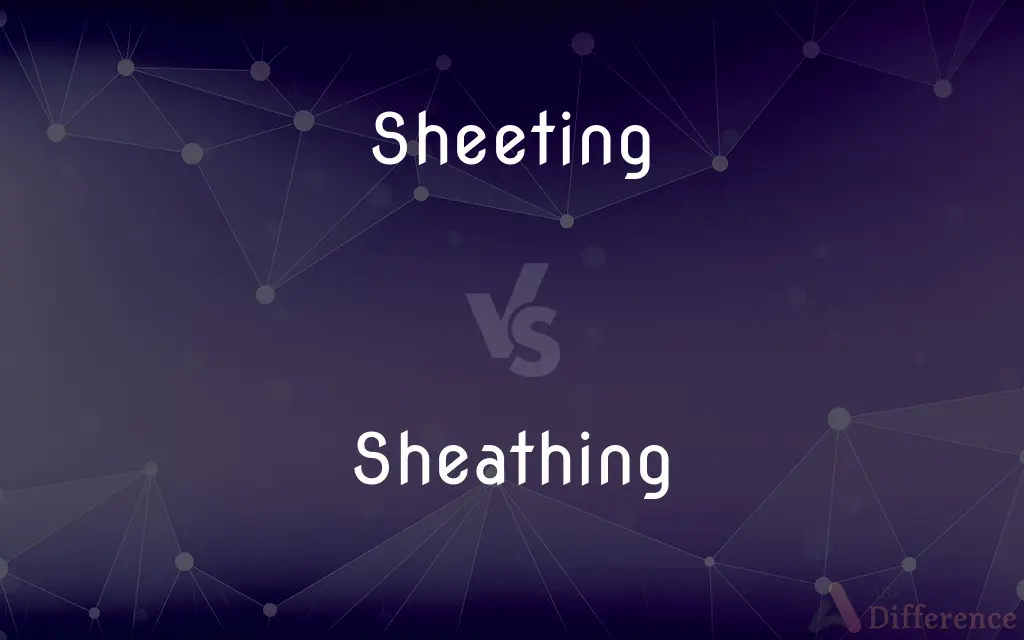Sheeting vs. Sheathing — What's the Difference?
Edited by Tayyaba Rehman — By Maham Liaqat — Updated on March 22, 2024
Sheeting refers to thin layers of material spread out to cover something, often for protection or separation, while sheathing involves the application of panels or boards on the exterior of structures, primarily for structural support.

Difference Between Sheeting and Sheathing
Table of Contents
ADVERTISEMENT
Key Differences
Sheeting is commonly used in various contexts, such as construction, where it might refer to the thin layers of plastic or fabric used to protect surfaces during painting or building activities. On the other hand, sheathing is a term frequently associated with construction and carpentry, where it refers to the panels or boards that are installed on the exterior walls of buildings under the exterior siding.
The thickness and material composition of sheeting can vary widely based on its intended use, from very thin plastic sheeting used in painting or gardening to thicker, more durable fabric sheeting for industrial applications. Sheathing, however, is generally made from more rigid materials designed to withstand structural loads and outdoor environmental conditions, making it essential for the integrity and longevity of building constructions.
While sheeting is primarily protective and often temporary or replaceable, sheathing is a fundamental part of a structure’s envelope, intended to last the life of the building. Sheeting might be used to temporarily protect a floor during construction, whereas sheathing is permanently affixed to the building's frame to provide ongoing support and protection.
Despite their differences, both sheeting and sheathing play crucial roles in construction and other industries, providing protection, structural support, and insulation. The choice between sheeting and sheathing depends on the specific requirements of the project, including the need for durability, structural support, and environmental protection.
Comparison Chart
Definition
Thin layers of material used for protection or separation.
Panels or boards applied to the exterior of structures for support or as a base for external layers.
ADVERTISEMENT
Primary Use
Covering or protecting surfaces.
Providing structural support and base for exterior siding.
Material
Can vary widely, including plastic, fabric, and metal.
Typically rigid materials like plywood, OSB, or foam boards.
Durability
Ranges from temporary and disposable to more durable options.
Designed to be durable and last the life of the building.
Function
Acts as a barrier against environmental factors.
Contributes to structural rigidity and insulation.
Compare with Definitions
Sheeting
Versatile in application, from painting to landscaping.
Sheeting was used to collect leaves during the fall cleanup.
Sheathing
Enhances the structural integrity of buildings.
Sheathing helped to stiffen the structure against wind loads.
Sheeting
Often used in healthcare settings for hygiene.
Disposable sheeting is changed frequently in hospitals to maintain cleanliness.
Sheathing
Integral to building construction for external walls.
Plywood sheathing was installed before the siding.
Sheeting
Used in construction to cover floors or furniture during work.
The workers laid down plastic sheeting to protect the hardwood floors.
Sheathing
Material choice depends on building requirements.
OSB sheathing was chosen for its strength and cost-effectiveness.
Sheeting
Available in various materials for specific needs.
Waterproof sheeting was applied over the outdoor event space.
Sheathing
Installed permanently as part of the building envelope.
The new sheathing was part of the home's renovation plan.
Sheeting
Can serve as a barrier in agricultural applications.
Frost-resistant sheeting was used to protect the crops.
Sheathing
Provides a base for additional layers like insulation.
The sheathing also served as a base for the spray foam insulation.
Sheeting
Material formed into or used as a sheet
A window covered with plastic sheeting
Sheathing
A layer of boards or of other wood or fiber materials applied to the outer studs, joists, and rafters of a building to strengthen the structure and serve as a base for an exterior weatherproof cladding.
Sheeting
Material, such as metal or cloth, formed into or used to form sheets.
Sheathing
(Nautical) An exterior covering on the underwater part of a ship's hull that protects it against marine growths.
Sheeting
The act or process of providing with or forming into sheets.
Sheathing
The act of providing sheathing.
Sheeting
Fabric used to make sheets (bedding).
Sheathing
Something that wraps around or surrounds something, as a sheath encases its blade.
When the sheathing was on it suddenly looked like a real house: you could see where the outer walls would be even if they still needed the siding and trim added.
Sheeting
The process of forming material into sheets.
Sheathing
Present participle of sheathe
Sheeting
(engineering) A lining of planks or boards for protecting an embankment.
Sheathing
Inclosing with a sheath; as, the sheathing leaves of grasses; the sheathing stipules of many polygonaceous plants.
Sheeting
(geology) A weathering process in which rock breaks into sheets after compressional stress on it is removed.
Sheathing
That which sheathes.
Sheeting
Present participle of sheet
Sheathing
Protective covering consisting, for example, of a layer of boards applied to the studs and joists of a building to strengthen it and serve as a foundation for a weatherproof exterior
Sheeting
Cotton or linen cloth suitable for bed sheets. It is sometimes made of double width.
Sheeting
A lining of planks or boards (rarely of metal) for protecting an embankment.
Sheeting
The act or process of forming into sheets, or flat pieces; also, material made into sheets.
Sheeting
Fabric from which bed sheets are made
Common Curiosities
What is sheeting used for?
Sheeting is used to cover or protect surfaces, acting as a barrier against moisture, dust, and other environmental factors.
How is sheathing installed?
Sheathing is installed by affixing panels or boards to the exterior framing of a building, usually with nails or screws.
What is the difference between sheathing and siding?
Sheathing is a structural layer installed directly on the building’s frame, while siding is the outermost layer exposed to the environment, providing aesthetic appeal and additional protection.
What role does sheathing play in construction?
Sheathing provides structural support, contributes to insulation, and serves as a base for exterior siding in building construction.
Can sheeting be used outdoors?
Yes, certain types of sheeting are designed for outdoor use, such as protecting plants from frost or covering materials during construction.
Are there different types of sheathing materials?
Yes, sheathing materials include plywood, oriented strand board (OSB), and foam boards, each offering different benefits in terms of strength, insulation, and moisture resistance.
Can sheeting be reusable?
Some sheeting, like certain fabrics or durable plastics, can be reused for the same or different purposes, depending on its condition and the specific application.
How does sheathing contribute to a building’s insulation?
Sheathing can enhance insulation by providing an additional layer that reduces thermal bridging and, in some cases, directly incorporates insulative properties.
Is all sheeting waterproof?
Not all sheeting is waterproof; the material and treatment determine its resistance to water. Waterproof options are available for specific needs.
How do you choose the right sheathing material?
Choosing the right sheathing material depends on factors like climate, building design, and specific requirements for strength, moisture resistance, and insulation.
Share Your Discovery

Previous Comparison
Solo vs. Single
Next Comparison
Terminology vs. JargonAuthor Spotlight
Written by
Maham LiaqatEdited by
Tayyaba RehmanTayyaba Rehman is a distinguished writer, currently serving as a primary contributor to askdifference.com. As a researcher in semantics and etymology, Tayyaba's passion for the complexity of languages and their distinctions has found a perfect home on the platform. Tayyaba delves into the intricacies of language, distinguishing between commonly confused words and phrases, thereby providing clarity for readers worldwide.
















































